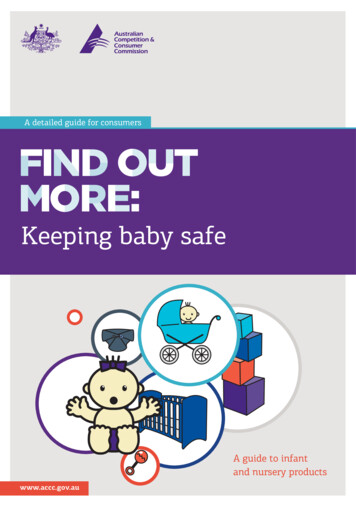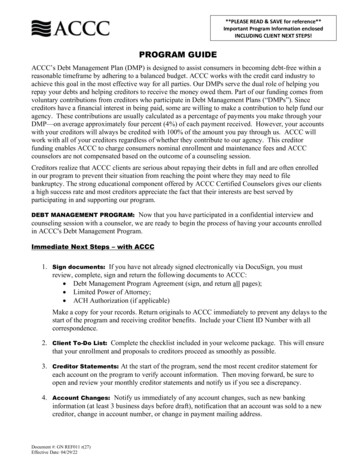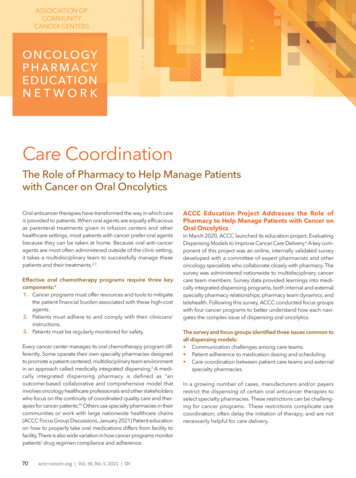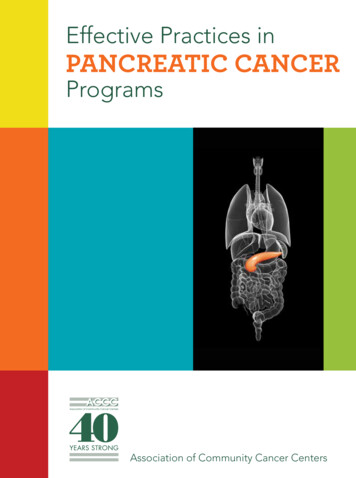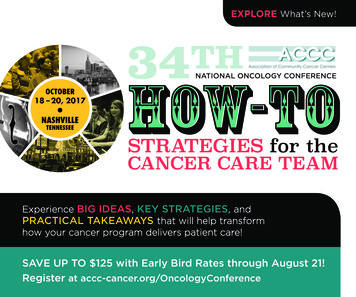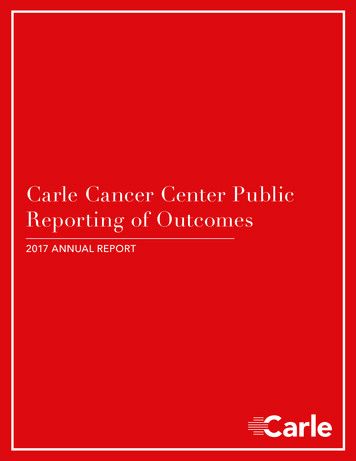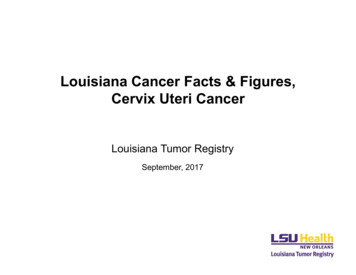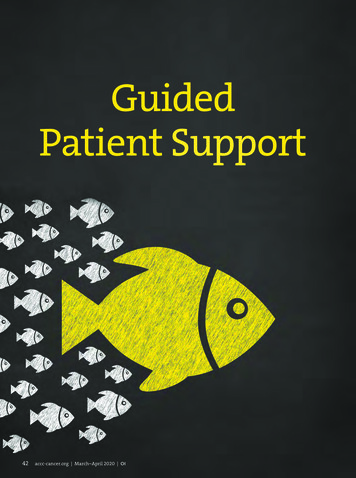
Transcription
GuidedPatient Support42accc-cancer.org March–April 2020 OI
BY JESSICA SIMA, MSN, RN, ACM; LORA ANDERSON, RD, CSO, LDN;MARIANNA WOLFMEYER, LCPC, DCC, CT;AND JILL BENEDECK, MS, APRN, AGCNS-BC, AOCNSHelping patients navigate the clinical,psychosocial, and financial aspects ofcancer careAt Northwestern Medicine McHenry Hospital CancerCenter, McHenry, Ill., the Guided Patient Support (GPS)Program is helping patients navigate life and care aftertheir cancer diagnosis. This innovative program provides coordinated whole-person care, ensuring that patients receive thesupport they need through psychosocial counseling, social support,rehabilitation services, financial counseling, nurse navigation,nutritional intervention, transportation assistance, physical therapy, tertiary care referrals, and medication assistance. The GPSapproach helps the cancer care team proactively identify patientneeds and prepare patients for treatment. Patients who haveparticipated in the program say that they feel more connected totheir cancer team and experience better quality of life throughoutthe cancer care continuum.Making the Case for Coordinated CareIn the 1990s, Northwestern Medicine McHenry Cancer Center(formerly Centegra Sage Cancer Center) expanded its cancerservice line and began providing adjunct services to patientsreceiving medical, radiation, and surgical oncology care. Thehospital subsequently added staff through the years, building ateam of experienced professionals, including:The GPS Program begins with a singleappointment in which patients and theircaregivers meet with all members of theteam and learn about the specializedservices they offer throughout the cancercare continuum. Oncology dietitianLicensed clinical social support counselor and chaplainSocial workerFinancial counselorPhysical, speech, and occupational therapistsGenetic counselorOncology nurse navigatorSupport services administrative coordinator.OI March–April 2020 accc-cancer.org43
At first, referrals to these support services were largely based onrecommendations from physicians and other clinicians who werepart of the patient care team. So, for example, if patients toldtheir medical oncologists that their appetites had decreased duringtheir treatments, physicians would refer them to the oncologydietitian. Patients who seemed to struggle with the emotionalburden of cancer care were referred to social support/counseling.Although patients could receive multiple referrals, these referralswere not coordinated, meaning that patients were not alwaysaware of the full range of services available to them. As a result,at times different members of the supportive care staff foundthemselves making multiple calls to the same patient on the sameday. Further, support team members were spread out in differentlocations throughout the cancer center, making care coordinationchallenging.Patients may also be referred by independent physicians, clinicians,and community members who know about the GPS Program.Currently, Northwestern Medicine patients who are diagnosedat our breast center, all patients receiving radiation consults, andall new patients to our infusion center are contacted by oursupport services administrative coordinator, who introduces theGPS program and schedules the appointments. Appointmentsare made at that time for a future GPS session. Patients who arenot ready to decide are encouraged to reach out to the coordinatorwhen they are ready for support. Patients do not have to gothrough GPS to access supportive care services; they may bereferred directly to any members of the support team individuallybefore, during, or after treatment.Developing the GPS ProgramThe supportive care team designates three hours every Wednesdaymorning for initial (first-time) GPS patient sessions. During thesesessions, patients meet with each member of the multidisciplinarycare team for 20 minutes. Our nurse navigator, dietitian, rehabilitation specialist, financial counselor, and social support/counseling specialist each conduct a screening or assessment of eachpatient’s needs and describe the services they provide. Follow-upappointments are scheduled as appropriate, and patients areassured that even if services are not currently needed, they areavailable at any time in the future. Patients are also educatedabout additional services, including support groups and programming, genetic counseling, American Cancer Society programs,transportation options, and tobacco cessation support (see Table1, right). These initial GPS sessions have been successful becauseeach member of the supportive care team contributes to the careof the whole patient.To streamline care, in 2018 Northwestern Medicine McHenryHospital Cancer Center consolidated its support services into adedicated office suite called the Cancer Resource Center. Thisresource center was made possible through a generous grant fromthe Northwestern Medicine Foundation. The resource center isdesigned to give patients a centralized location for cancer supportservices, increasing staff efficiency and more effectively connectingpatients with the supportive care providers they need.That same year the Cancer Resource Center team developedthe GPS Program for newly diagnosed patients and their families.Using the GPS Program, the team created a roadmap for thesupport resources available throughout the cancer center. TheGPS Program begins with a single appointment in which patientsand their caregivers meet with all members of the team and learnabout the specialized services they offer throughout the cancercare continuum. Ideally, patients attend this initial GPS sessionshortly after their diagnosis, as their plan of care is being developed. (To allow patients and their families time to process information received at their initial medical consultation, this first GPSappointment is scheduled on a different day.) Referring patientsto the GPS Program—rather than to individual services—hasresulted in a more coordinated, comprehensive approach tosupportive care. Patients may be referred to the GPS program inseveral ways, depending on the type of oncology services theyrequire: Physician referral. A medical oncologist or surgeon may referpatients to the GPS Program to ensure that their care is comprehensive and coordinated. Breast center referral. The breast health navigator often referspatients to the GPS Program after diagnosis or after initialsurgery so that patients can immediately receive educationabout the wide range of support services available. Radiation Oncology. Patients who present for a radiationtherapy consult receive a visit from a support staff team member, who invites them to the GPS Program and schedulesvisits.44accc-cancer.org March–April 2020 OIThe Initial GPS SessionThe Oncology Nurse Navigator: Teaches patients about how she participates in their care atdifferent points in the continuum. Educates patients about their diagnoses and treatment options. Reviews comorbidities and hospitalizations. Begins to assess the patients and family’s need for support (seeFigure 1, page 46). Uses an evidence-based tool (modeled after the Billings Clinic’spatient navigation acuity scale) to determine a patient’s navigation acuity score. Based on the results, she is able to prioritize patient care and can make community referrals regardingtransportation needs, psychosocial support, insurance options,and second opinions (see Figure 2, page 47). Prioritizes the level of follow-up needed as well as the timingof a follow-up call or appointment, as patients with advanceddisease, such as head and neck cancer, require more coordination and support as they adjust to their cancer diagnoses. Sets a timeline for future discussion about the patient’s survivorship care plan.
The Oncology Dietitian: Reviews the patient’s plan of care and conducts a malnutritionscreening (Figure 3, page 48), which helps determine whethernutrition intervention is necessary. Reviews the patient’s appetite, hydration, weight changes, andpotential side effects of treatment. Teaches about diet modification, substitutions, andsupplements. Schedules follow-up appointments with patients to help themgain a deeper understanding of how to eat nutrient-densemeals that are essential during treatment and recovery. Educates patients about enteral feeding, if indicated.The Rehabilitation Specialist (depending on the patient’streatment plan): Helps patients get the most out of daily living by maximizingtheir cognitive, physical, and social functioning. Assesses the need for patients to receive speech and swallowtherapy and lymphedema management. Helps patients understand how cancer and its treatments affectactivities of daily living. Identifies immediate needs and educate patients about potentialtreatment side effects that could signal a need for additionaltherapy support.The Physical Assessment Screening Tool can be found on page49 (Figure 4).The Financial Counselor: Helps patients understand their financial responsibilities. Reviews a patient’s insurance coverage, explains out-of-pocketexpenses, and identifies the potential for financial distress orfinancial toxicity. Educates patients about resources that may be available tohelp them, offering information about programs for whichthe patient may be eligible to relieve the financial burden ofcare.The Social Support Counselor: Discusses with patients and their families how cancer and itstreatment affect not only the physical body but also the emotional, mental, spiritual, and social aspects of life. Asks patients to complete an evidence-based distress selfassessment adapted from the American Cancer Society (seeFigure 5, page 50) that addresses issues including: Symptoms of anxiety and depression Changes in sleeping habits, focus, and appetite Cancer’s interference with daily family, social, and sexlife Pain, discomfort, and physical limitations Physical, emotional, spiritual, and/or financial hardshipcaused by cancer Body image concerns Coping Overall quality of life.Table 1. Additional Supportive Care Servicesand Resources Support groupsHome care and nursing home resourcesEducational programsPharmaceutical program assistanceTransportation assistanceGrief counseling and “Living with Grief” programPalliative care and hospice referralsMassage therapyWellBridgeTobacco cessation programAmerican Cancer Society program referralsWig BoutiqueSurvivorship programming.If the self-assessment indicates a moderate to high level ofdistress, the counselor encourages patients to participate inindividual counseling, support groups, and other programmingopportunities. The counselor also educates patients aboutemotional distress that may develop over time. Patients andfamily members are often surprised to learn that distress canincrease after treatment ends, when they have time to reflecton the ways in which their lives have been altered bycancer.Information from GPS Program visits is integrated into the medicalrecord through scheduling, charting, and scanning. Each visit isscheduled and captured in the patient’s medical record as well ascharted in progress notes. Any written screening tools used arescanned into the patient’s medical record. This information isavailable to the clinical team.Ongoing SupportThe Cancer Resource Center offers supportive care services longafter treatment has ended. The support team helps develop eachpatient’s survivorship care plan, which includes information aboutoverall health maintenance and future cancer prevention measures,the importance of adhering to follow-up appointments and testingan established timetable, and instruction about exercise, nutrition,and ongoing emotional and medical management.We teach patients and their families how to identify futureissues that could benefit from the help of our supportive careteam post-treatment. Patients are encouraged to contact supportteam members any time after their treatment has concluded.Support services are free of charge and considered part of apatient’s care at the Northwestern Medicine McHenry CancerCenter.(continued on page 51)OI March–April 2020 accc-cancer.org45
Figure 1. Patient Navigation Intake FormName: Age:DOB:Contact number:Emergency contact person/number:Okay to leave messages:Primary insurance:Secondary insurance:Policy #: Phone #:1. How was the patient referred to the navigation program?2. What has your doctor told you so far?3. Biopsy date/result:4. Primary doctor:5. Med Onc:6. Rad Onc:7. Surgeon:8. Specialist (dental and urologist):9. Family history:10. Surgery:11. Chemo:Navigation Acuity ScoreHealth decision making1. Difficulty with decision making2. Wants second opinion3. Language or disability barrierHome Life1. Childcare issues2. Housing issues3. Transportation needs4. Food needsPhysical1. Activities of daily living2. Falls3. Fertility issuesEmotional1. Distress tool2. SupportLifestyle1. Smoking2. Alcohol3. DrugFinancial/Health Insurance1. Prescription coverage2. Difficulty paying bills3. Financial assistance46accc-cancer.org March–April 2020 OIReferral/order form completed: Yes / NoEducation materials given: Yes / NoContact numbers provided: Yes / NoSituation:Background:Assessment:Recommendation: Plan of care and follow-up (MD appointments, port placement, scans, dental forms or peg tubes,referrals for coverage):
Figure 2. Oncology Nurse Navigation Acuity ToolThe acuity scale will be applied at initial contact. Initial contact could include at consult, chart review prior to start of care, initial start oftreatment, initial navigation contact, or at the first doctor day. This number can be adjusted per the clinician’s discretion throughout treatment. This number is assigned during active treatment.Acuity Level 0(Guidelines and Considerations) In survivorship and stable Active treatment has ended Cancer in situ Distress scale 0-2(Care Coordination Focus) Meet with patient initially and assure distress screen is completed Navigation intake documentation completed and plan reviewedwith the patient Provide initial education/clinical coordination/referrals andsupport Follow-up only if requested by patient or providerAcuity Level 1(Guidelines and Considerations) Stage 1 Single-agent chemo or radiation only Starting surveillance/observation Performance Eastern Cooperative Oncology Group (ECOG) 0-1 Distress scale less than 3(Care Coordination Focus) Meet with the patient initially and ensure that distress screen iscompleted Navigation intake documentation completed and plan reviewedwith the patient Provide initial and ongoing education/clinical coordination/referrals and support Monitor every month for any new needs and document a follow upnote during treatmentAcuity Level 2(Guidelines and Considerations) New cancer diagnosis Stage 2 Multi-agent chemotherapy and/or radiation therapy Oral chemotherapy Performance ECOG 1-2 Distress scale 4-5(Care Coordination Focus) Meet with the patient initially and ensure that distress screen iscompleted Navigation intake documentation completed and plan reviewedwith the patient Provide initial and ongoing education/clinical coordination/referrals and support Monitor closely every three weeks or as needed for any new needsand document follow-up noteAcuity Level 3(Guidelines and Considerations) Hospitalized in the past 60 days Receiving multiple treatment modalities (chemo/rad/surgery) Serious comorbidities Head/neck/gastrointestinal cancer diagnosis Colostomy/ileostomy Non-compliant with treatment Performance ECOG 2-3 Distress scale 6-7 Stage 3 disease Little or no family support(Care Coordination Focus) Meet with patient initially Navigation intake documentation completed and plan reviewedwith the patient Provide initial and ongoing education/clinical coordination/referrals and support Monitor closely every two weeks or as needed for any new needsand document a follow-up note Maintain phone contact with the patient as needed in betweenvisits and document under notes Assist with care coordination during transitions of care (hospital,home health, etc.)Acuity Level 4(Guidelines and Considerations) Stage 4 disease Feeding tube Tracheostomy Frequent hospitalizations Unstable and/or end-stage disease Performance ECOG 3-4 Distress scale of 8-10(Care Coordination Focus) Meet with patient initially Navigation intake documentation completed and plan reviewedwith the patient Provide initial and ongoing education/clinical coordination/referrals and support Monitor closely every week or as needed for any new needs anddocument a follow-up note Maintain phone contact with the patient as needed in betweenvisits and document in notes Assist with care coordination during transitions of care (hospital,home health, etc.) Provide end-of-life support to patient/family/caregivers as neededResourcesAmerican Cancer Society. Tools to help measure distress. Availableonline at: -measure-distress.html. Last accessed June 8, 2015.Baldwin D, Jones M. Developing an acuity tool to optimize nursenavigation caseloads. Oncol Issues. 2018;33(2):17-25.Blaseg K, Daugherty P, Gamblin K, eds. Oncology Nurse Navigation:Delivering Patient-Centered Care Across the Continuum. Pittsburgh, PA:Oncology Nursing Society; 2014.OI March–April 2020 accc-cancer.org47
Figure 3. Nutrition Screening ToolPatient Name:DOB:Phone Number:Date:Check if form filled out by patient listed above:Nutrition Screening Score:Weight Changes Over the past month, I would rate my activity level as:Weight:poundsHeight:inchesNormal, with no limitations (0)Not my normal self, but able to be up and about most of theWeight 6 months ago:poundsWeight 1 month ago:poundsDuring the past 2 weeks, my weight has:Decreased (1)Not changed (0)Increased (0)Food IntakeDuring the past 2 weeks, I have eaten:My usual amount—no problem eating (0)More than usual (0)Less than usual (1)If less, I am now taking:Normal food but less than normal amount (1)Little solid food (2)Only liquids (3)Only nutritional supplement drinks (3)Very little of anything (4)I have (or will have) a feeding tube (4)I receive IV feedings (4)time with fairly normal activities (1)Not feeling up to most things but in bed or chair less thanhalf the day (2)Able to do little activity and spend most of the day in bed ora chair (3)Pretty much bedridden, rarely out of bed (3)SymptomsI currently have the following symptoms:No problems eating (0)No appetite, do not feel like eating (3)Nausea (1)Vomiting (3)Feel full quickly (1)Problems with chewing or swallowing (2)Depression (1)Dry mouth (1)Mouth sores (2)Smells bother me (1)Constipation (1)Diarrhea (3)Things taste funny or have no taste (1)Pain (3)Activity Level48accc-cancer.org March–April 2020 OI
Figure 4. Physical Assessment Screening Tool: Oncology Rehab and Support ServicesCompleting this form will help us partner together in your care. You may be asked to complete this assessment tool more than once duringyour cancer experience.Patient Name: DOB:Phone Number: Date:No1Are you having any joint or muscle pain? If yes, where?2Do your hands and/or feet feel numb or tingle? If yes, where?3Does any part of your body feel swollen? If yes, where?4Are you feeling weak or having trouble moving around?5Are you experiencing excessive tiredness/fatigue?6Are you having trouble concentrating or remembering things?7Are you having trouble with your balance?8Are you having trouble swallowing?9Are you having trouble taking care of yourself (bathing, dressing orgrooming)?10Are you having trouble with daily tasks like chores or shopping?11Are you having trouble driving?12Are you having trouble completing your tasks at work?Yes, and I would liketo address thisYes, but this has alreadybeen addressed. I don’tneed to discuss itPlease choose only one response for each question.ADo you exercise? Please circle: Yes or NoIf you answered yes, how many days a week?BIf yes, please specify what your exercise program consist of (i.e., strength training, cardio, etc.):CIf no, are you interested in more information about the programs that can help you get started with an exercise regimen?Please circle:Yes or NoPlease list what you are concerned about the most and that you would like to address immediately:This box is for internal use only.This form was reviewed by (please print):Date:OI March–April 2020 accc-cancer.org49
Figure 5. Evidence-Based Distress Self-Assessment*Name:Date:Support Recommended to Address Distress—Patient Self-AssessmentI have felt anxious or worried about cancer and the treatment I am receiving.Not at all12345All the timeI have felt depressed or discouraged.Not at all125All the timeI have been irritable or unusually angry and I have not controlled it well.Not at all12345All the timeMy sleeping habits have changed.Not at all1342345All the timeI have noticed a change in my appetite.Not at all12345All the timeI have had trouble focusing at work or at home or on routine things such as reading the newspaper or watching television.Not at all12345All the timeCancer and its treatment have interfered with my daily activities.Not at all12345All the timeCancer and its treatment have interfered with my family or social life.Not at all12345All the timeCancer and its treatment have interfered with my sex life.Not at all12345All the timePain and discomfort have caused me to limit my activities.Not at all12345All the timeCancer has caused physical, emotional, spiritual, and/or financial hardship for me.Not at all12345All the timeCancer and its treatment have caused changes in how I look, and this concerns me.Not at all12345All the timeI have had trouble coping with the distress I have been having.Not at all12345All the timeMy quality of life during the past 2 weeks has been:Excellent1235Very poor4If many of your answers are 4s or 5s, you may be having significant distress and it is recommended that you consider talking with acounselor or other mental health professional.*Adapted from the American Cancer Society. Tools to help measure distress. Available online at: o-measure-distress.html. Last accessed June 8, 2015.50accc-cancer.org March–April 2020 OI
(continued from page 45)Our ResultsDuring implementation of the GPS Program, our supportive careteam met weekly to address real-time issues as they arose. Today,the team meets biweekly to review the program and make adjustments as needed. Fourteen months after the program’s launch,our team continues to make improvements to enhance efficiencyand improve the patient experience. Our evaluation indicates: Number of patients offered GPS: 458 patients were offeredinformation on the GPS Program from October 2018 throughDecember 2019. Patient acceptance rate: 54 percent of patients accepted theoffer to attend the program.Patient acceptance rates of the GPS Program—measured bywhether patients attend the initial session—are not where theteam hoped they would be. Some of the reasons patients havegiven for refusing a GPS appointment include concern abouthaving multiple appointments, uncertainty about their plan ofcare, the belief that they already have enough support, concernabout lack of time, and the belief that they “don’t need it.” Theteam has found that patients are often so focused on their medicaltreatment plans that they are unable to absorb much more information early on. Many times, it is someone close to the patientwho recognizes the need for supportive care, whether it is for thepatient or for him- or herself as a caregiver.While not every patient accepts the referral to the GPS Program,many who do attend say that they did not know they needed theteam’s services until they met the specialists who provide supportive care. Based on the low acceptance rate, we have changedthe scripting of how the GPS Program is presented to patients. Itis now described as an integral part of care rather than optional.In the next year we have a robust list of additional areas we areaddressing. We increased our time from three hours a day to sixhours on Wednesdays, noting a need for afternoon options andtime to see more patients. We will add reminder calls prior toscheduled appointments to increase attendance rate. Our reachwill now include Northwestern Medicine medical oncology officesopening in 2020, adding a social worker to our support team,and including new screening tools. We are looking to conduct aparticipant survey to identify barriers to care or gaps in resourcesprovided, and gather feedback to help analyze our program andidentify areas for improvement. Upcoming enhancements to theelectronic medical record will allow for standardized templates,decreasing the team’s time spent charting and scanning.Initial OutcomesFrom the launch of the GPS Program, it has been important tothe team to monitor how and whether the program is impactingpatients’ use of supportive care and services in ways that improvethe quality of patients’ overall cancer experience. Early outcomesfor the program indicate that patients’ needs are being moreefficiently and effectively served as care and services are beingoffered to and used by more patients and families affected bycancer. Supportive care services are also being offered to peopleThough all patients said that the GPSProgram was beneficial, one messagewas particularly consistent: patients feltmore closely connected to members ofour team and were more likely to use ourservices after they participated in theGPS Program.earlier in their cancer treatment. These earlier, proactive interventions are reducing the severity and length of challenges thatpatients face in cancer management. For example, patients whoare less worried about finances, appointments, and transportationhave more time and energy to devote toward their physical andemotional health and wellness. Patients have even verballyexpressed decreased anxiety with just knowing who—and when—to contact if, and when, a need arises. Below are some of thefindings and outcomes data we have seen after implementationof our GPS Program: Nutrition screening scores during GPS showed 84 percent lowrisk, 14 percent moderate risk, and 1 percent high risk formalnutrition. Typically patients receive nutrition counselingafter initial cancer treatment. Therefore, nutrition screeningduring GPS provides the opportunity for early nutrition intervention and discussion of side effect management or initiationof enteral nutrition support. GPS has allowed us to identify patients who need transportation prior to the start of treatment, ensuring availability ofthe bus service and avoiding a delay in the start oftreatment. Thirty patients and/or family members received supportivecounseling as a direct result of connecting with the counselorthrough the GPS Program. Fewer individual referrals resulted in fewer phone calls topatients, improving continuity of care. The financial counselor assisted 40 patients in applying forvarious programs, including 11 patients who applied forfinancial assistance, 7 patients who signed up for Medicaid,9 patients who applied to foundations grants/co-pay programs,4 patients who were found eligible to receive supplementsfrom Medicare, 4 patients who were enrolled in medicationreplacement programs, and 13 patients who received helpwith co-pays, deductibles, and/or out-of-pocket costs. (Note:Some patients were eligible and signed up for more than oneprogram.) Twenty-four percent of patients seen by the nurse navigatorwere assigned with an acuity level 4, which is the highest levelof acuity. The GPS Program allowed for early face-to-facecontact with high-acuity patients and their families. The meeting time has allowed for reinforcement (and continuedOI March–April 2020 accc-cancer.org51
Early in the program, it became evident that our initial follow-upmethod—gathering feedback through telephone calls from theteam’s manager—was not working due to time constraints. Weare now using a post-GPS survey card (Figure 6, right) in thehope that it will gather more feedback for the team about thevalue of the program.The dietitian counseling session led to an assessment that thepatient was at mild risk for nutritional issues due to reportedpain, dysphagia, and taste changes. The patient had already lostweight prior to the start of treatment, and the dietitian providedcounseling about the reasons a feeding tube was indicated. Sheexplained how the tube would be inserted and described feedingschedules to proactively educate the patient.The nurse navigator’s discussion ensured that the couple wasprepared for the upcoming treatments, and they seemed organizedand informed about the care that was planned. The navigatorreviewed upcoming clinical appointments with the couple, whichincluded the percutaneous endoscopic gastrostomy port, dentalclearance, medical imaging, fertility visits, a swallow study, andmedical oncology visits. At the time, there were no home life,physical, or lifestyle issues identified.The physical therapy evaluation included education aboutpost-treatment lymphedema therapy, and the therapist providedthe patient a referral to a swallow evaluation.During their meeting with the social support counselor, thepatient and spouse each acknowledged a history of anxiety anddepression and described the ways in which they had dealt withand continued to address their individual mental health concerns.The couple agreed that future counseling specifically related tothe challenges of living with and beyond cancer and treatmentcould be helpful, but they did not immediately schedule servicesbecause they had so many other clinical appointments scheduledalready.During the financial counseling session, our counselor explainedthat t
their cancer team and experience better quality of life throughout the cancer care continuum. Making the Case for Coordinated Care. In the 1990s, Northwestern Medicine McHenry Cancer Center (formerly Centegra Sage Cancer Center) expanded its cancer service line and began providing adjunct services to patients
